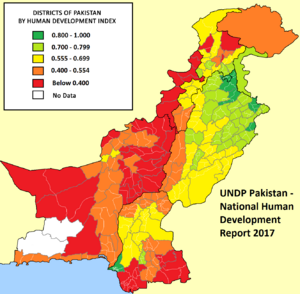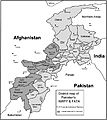War in North-West Pakistan facts for kids
An insurgency is a long-term conflict where a group fights against the government. The insurgency in Khyber Pakhtunkhwa is also called the War in North-West Pakistan. It involves Pakistan and several armed groups. These groups include the Tehrik-i-Taliban Pakistan (TTP), al-Qaeda, and their allies. Some of these allies come from Central Asia.
This conflict began in 2004. It started when the Pakistan Army searched for al-Qaeda fighters in the Waziristan area. This area is mountainous and was part of the Federally Administered Tribal Areas. Pakistan's actions were part of its help in the U.S. War on Terror.
More fighting happened between the Pakistan Armed Forces and militant groups from Central Asia. These groups were joined by fighters from the Afghan War. They later formed groups like the TTP.
This conflict has been very costly for Pakistan. It has affected the country's people and its economy. Since 2001, Pakistan has lost over $126 billion. This is because of its role as a "frontline state" in the War on Terror.
In 2014, the Pakistani military launched a big operation against the Pakistani Taliban. Many of their leaders then went to Afghanistan. After this, the number of people hurt by terrorism in Pakistan dropped by 40% by 2014. This was compared to the years 2011–2013. Even in Khyber Pakhtunkhwa, where a tragic school attack happened in December 2014, the numbers dropped. The fighting became less intense, changing from a full-scale war to a smaller, "low-level" conflict.
In June 2022, the Tehreek-e-Taliban and the government agreed to a ceasefire. However, in November 2022, the Tehreek-e-Taliban ended the ceasefire. They then called for attacks across Pakistan.
Contents
Understanding the Conflict's Names
People and historians have used different names for this conflict. In English, it is known as the Insurgency in Khyber Pakhtunkhwa. Other names include the War in North-West Pakistan or Pakistan's War on Terror. Some also call it the Waziristan War. A political expert, Farrukh Saleem, called it the "Fourth Generation War" or "4G War."
Working Towards Peace and Progress
Since 2006, the government has worked to rebuild areas affected by the conflict. These areas are in FATA and Khyber Pakhtunkhwa. Lieutenant-General Nadeem Ahmad helped manage much of this rebuilding. He worked with the National Disaster Management Authority (NDMA).
The government started many projects to help these areas. They encouraged political activities and built new roads. They also set up an Investment Bank for FATA. These efforts aimed to create jobs and bring wealth. About ₨ 1 billion was spent to help people who had to leave their homes. Another ₨ 500 million went to the Khyber Pakhtunkhwa government for economic growth.
Many international groups and the UN have also helped rebuild these areas. Since 2005, several government groups have worked on recovery and development. These include:
- US Aid
- National Reconstruction Bureau (NRB)
- National Disaster Management Authority (NDMA)
- Earthquake Reconstruction and Rehabilitation Authority (ERRA)
- Special Support Group for IDPs (SSG)
- Federal Relief Commission (FRC)
- National Logistics Cell (NLC)
- Frontier Works Organisation (FWO)
- Navy Reconstruction Group (NRG)
From 2006 to 2015, a nine-year plan aimed to spend over $2.06 billion on rebuilding the FATA region. The U.S. Government promised $750 million over five years. Since 2010, army engineering units have been active in rebuilding. Groups like the Frontier Works Organisation (FWO) have built over 400 km of roads, dams, and canals. They also started work on the Gomal Zam Dam in Waziristan. Local tribal people were hired to help with this big project.
The Pakistan Army also helped restart political and educational activities. They rebuilt damaged schools and colleges. Since August 2011, many young people from tribal areas have been able to join army institutions for education.
In 2017, Pakistan began building a fence along its border with Afghanistan. This fence is 2,611 kilometers long. It helps stop militant attacks from crossing the border. By August 2021, 90% of the fence was finished. It is made of two 4-meter high fences with barbed wire in between.
People Affected by the Conflict
In October 2011, the ISPR reported on the impact of the conflict. They stated that about 3,097 soldiers and personnel were killed. Another 721 were permanently injured. The ISI lost 63 of its staff in attacks. The report also confirmed that since 2001, around 40,309 Pakistanis, both military and civilians, had lost their lives in the conflict.
Images for kids
-
Air Intelligence map: Map showing the air domain of the districts of the Tribal areas (FATA) and the Khyber-Pakhtunkhwa province of Pakistan.
-
Military intelligence map: In 2007, the Uzbek IMU dominated the South Waziristan before forced out from the country by tribes and the armed forces in 2008.
-
Pakistan airborne forces captured the highest point in Swat valley, 2009.
-
An MQ-9 taking off in Afghanistan.
-
Pakistan's airborne troops performed combat jump operations from PAF's C-130 Hercules aircraft, 2010.
-
A vintage photo of South Wazristan's mountains, primary hideouts of TTP before being pushed to Eastern Afghanistan by the military in 2009.
-
US Defence Secretary Robert Gates laying flowers and straightens out a wreath to commemorate the soldiers and personnel of Pakistan military in 2010.
-
CNS Adm Noman Bashir shakes hand with General David Petraeus to strengthen the partnership with the United States.
See also
 In Spanish: Guerra de Jaiber Pajtunjuá para niños
In Spanish: Guerra de Jaiber Pajtunjuá para niños













